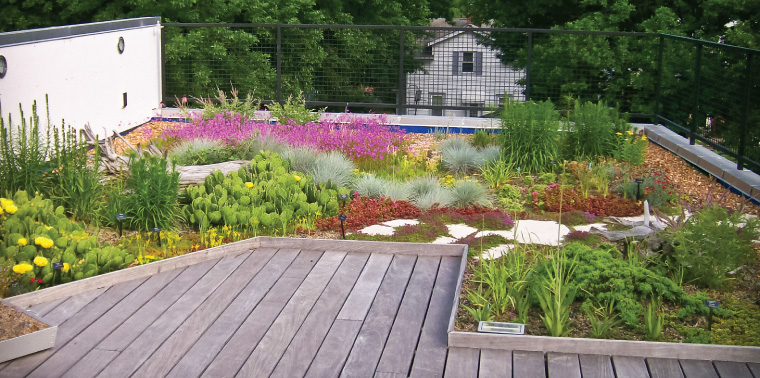September 30, 2013 — Landscaping can do more than increase property values. It can reduce energy use and clean air and water while providing wildlife habitat and connecting people to nature.
Such benefits are now measurable — thanks to guidelines and a rating system developed by the Sustainable SITES Initiative™, a program of the American Society of Landscape Architects, the Lady Bird Johnson Wildflower Center at the University of Texas at Austin, and the U.S. Botanic Garden.
Designers or site owners can submit any type of landscaping project for SITES certification. To earn SITES credits they provide documentation of sustainable strategies used. SITES certification, like LEED ratings, can be a marketing advantage. It also makes the public aware of both the firm’s and the client’s commitment to sustainability.
Sustainable Standards
The SITES initiative uses a set of 10 standard guidelines covering categories such as water use and stormwater management, vegetation and soil, energy use, operation and maintenance, and performance monitoring.
Credits can come from managing as much stormwater runoff as possible onsite in a way that makes it an asset (free water for irrigation and other nonpotable uses) instead of a liability. Features such as roof gardens, rain gardens, pervious pavers on walks and parking lots, percolation pits, and sumps can contribute to this goal.
Total credits determine which certification level a project achieves — one to four stars.Reducing energy is another goal for sustainable landscaping, and green roofs can reduce the need for heating and cooling. Other strategies include using deciduous trees on the south to block summer heat and evergreens on the north as a winter windbreak.
Protecting aquatic ecosystems and reusing salvaged plants can earn credits, too. Total credits determine which certification level a project achieves — one to four stars.
Road Map
Nearly two dozen projects have earned SITES certification since the initiative launched in 2009. They include a Pennsylvania residence; Cleveland’s Public Garden; Scenic Hudson Long Dock Park in Beacon, N.Y.; George “Doc” Cavalliere Park in Scottsdale, Ariz.; and the SWT Design campus in St. Louis, Mo.
At SWT, landscaping demonstrates commitment to sustainable practices and serves as a living laboratory for staff. Zach Snovelle, SWT’s landscape architect in training, says that the rigorous documentation required for SITES certification was very challenging.
SWT designers chose Missouri native plants such as prickly pear and flame flower. They added a rain garden beneath a bridge that connects their two buildings. With roof gardens, a rain garden, pervious pavers on walks and parking lot, percolation pits, and sumps, SWT manages more than 95 percent of its stormwater on its one-third-acre site.
The SWT Design campus and the other innovative projects show that landscaping offers numerous ways to deliver environmental benefits.SWT’s green roof not only reduces energy needs, it also inspires creativity and lowers stress for SWT employees, according to SWT co-founding principal Jim Wolterman. Clients, too, seem to enjoy the space. In fact, “it’s difficult to get them to come inside to a conference room,” Wolterman says.
The SWT Design campus and the other innovative projects show that landscaping offers numerous ways to deliver environmental benefits. The SITES rating system makes that sustainability measurable and easier for everyone to understand. And SITES provides a valuable incentive for going the extra mile.
“Even though we were very much involved with being sustainable, it’s pushed us to go further,” Wolterman says. “It has provided us a road map.” ![]()
Ensia shares solutions-focused stories free of charge through our online magazine and partner media. That means audiences around the world have ready access to stories that can — and do — help them shape a better future. If you value our work, please show your support today.
Yes, I'll support Ensia!
